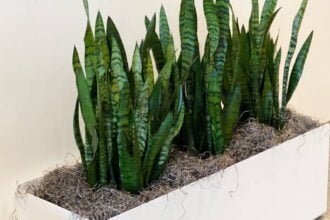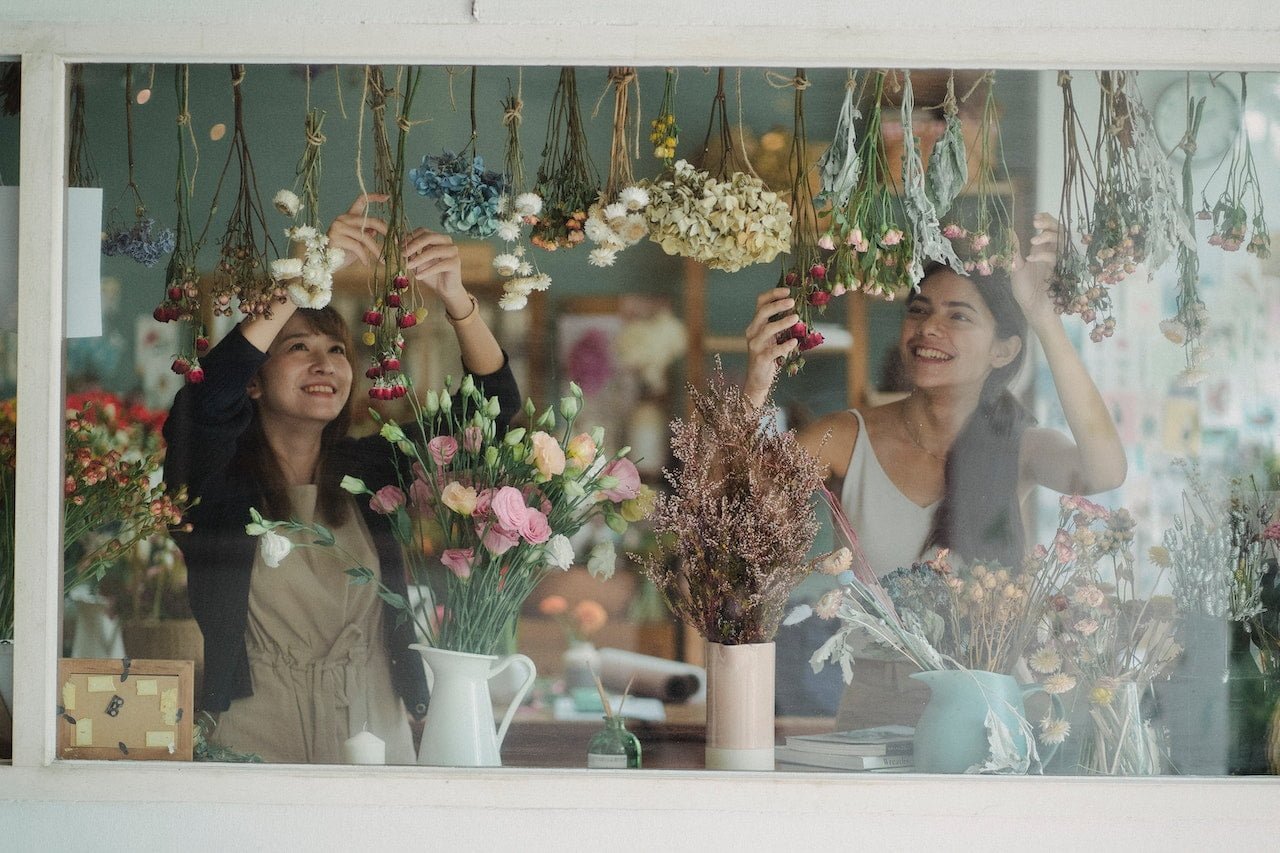The Alocasia Black Velvet is a beautiful houseplant that can elevate any interior design. It is a favorite among gardeners because of its huge, glossy leaves and unique, velvety black texture.
As an indoor plant, it not only looks nice, but it also helps clean the air and lifts your spirits. In this article, we’ll discuss the perks of having an Alocasia Black Velvet in your home, as well as how to take care of the plant so that it always looks its best.

Alocasia Black Velvet Appearance
The Alocasia family includes the beautiful Black Velvet Alocasia. It stands out among other Alocasia varieties due to its unusual appearance. Find out what gives this plant its velvety black appearance and how it compares to other Alocasia species in this in-depth description.
1. Plant’s Physical Features
- Leaves: Alocasia Black Velvet has enormous, heart-shaped leaves that are as soft as velvet. They can reach a length of 2 feet and have a dark green hue with pronounced veins.
- Stem: The plant has a tall, sturdy stem that is the same dark hue as the leaves. It has a potential height of 3 feet.
- Roots: The plant has thick, fleshy roots that help it absorb nutrients and water from the soil.
- Flowers: When Alocasia black velvet does bloom, the blooms are tiny and unassuming.
2. Comparison to Other Alocasia Plants
When compared to other Alocasia species, Alocasia Black Velvet certainly stands out. Some important distinctions are as follows.
- Leaf Texture: Alocasia Black Velvet is distinguished from other Alocasia species by the velvety feel of its leaves.
- Leaf Color: The leaves of most Alocasia plants are green, while others have white or yellow patterns. Alocasia Black Velvet, in contrast, has uniformly dark green foliage.
- Plant Size: The maximum height for an Alocasia Black Velvet plant is three feet. The “Big Elephant Ear,” or Alocasia macrorrhiza, on the other hand, can reach a height of 8 feet.
3. Explanation of Black Velvet Texture
The Alocasia Black Velvet gets its name from the velvety feel of its leaves. Trichomes, which resemble tiny hairs, give the leaf its characteristic texture.
Specialized cells within these trichomes secrete a waxy material that provides the leaf its velvety texture. These trichomes serve to prevent insects and herbivores from grabbing hold of the plant and causing damage by making the surface rough and impenetrable.
Anthocyanin, a pigment produced in reaction to light and temperature variations, gives the leaves their dark hue. This pigment has a dual purpose of shielding the plant from harmful UV rays and other environmental pressures.
Benefits of Having Alocasia Black Velvet as an Indoor Plant
1. Purification of Indoor Air
The ability of Alocasia Black Velvet to purify the air inside a home is one of the plant’s primary advantages. During photosynthesis, Alocasia Black Velvet takes carbon dioxide from the air and gives off oxygen. Furthermore, it aids in the elimination of formaldehyde, benzene, and xylene, all of which are common indoor air pollutants.
Carpets, furniture, and cleaning supplies are all potential sources of these pollutants, which have been linked to respiratory problems, headaches, and other symptoms. The Alocasia Black Velvet plant can remove these harmful gases from the air, making the home a healthier place to be.
2. Improvement of Indoor Aesthetics
The Alocasia Black Velvet is a beautiful plant that can make any room feel more sophisticated. Because of its strong stem and lush, dark green leaves, this plant is a conversation starter wherever it is placed.
Its moderate proportions allow it to be placed almost anywhere without appearing out of place. Alocasia Black Velvet can do wonders for the decor of whatever room it is placed in, whether that be a corner, a windowsill, or a table.
3. Stress Reduction and Mood Enhancement
Having plants inside has been demonstrated to improve mental health and decrease stress. In this regard, Alocasia Black Velvet is not unique. Taking care of a plant by watering it and trimming it may be a relaxing and rewarding activity in and of itself.
In addition, studies have found that having plants around the house provides a relaxing impact that aids in stress reduction and increases relaxation. Plants have been shown to enhance air quality, which has been linked to enhanced health benefits.
Caring for Alocasia Black Velvet
The Alocasia Black Velvet is a beautiful plant that needs special attention to flourish. Some advice on how to keep your Alocasia Black Velvet plant healthy:
1. Choosing the Right Pot and Soil
Since Alocasia Black Velvet thrives best in porous, well-drained soil, a container with drainage holes is essential. The ideal soil pH ranges from 5.5 to 6.5 and is rich in organic matter like peat moss or compost. In addition, the pot should be a little bigger than the root ball to accommodate expansion.
2. Temperature and Humidity Requirements
Temperatures between 65 and 80 degrees Fahrenheit (18 and 26 degrees Celsius) are ideal for the Alocasia Black Velvet plant. Avoid placing the plant near drafty windows or heating vents, especially in direct sunlight. Humidity can be increased by using a humidifier or by placing a tray of water near the plant.
3. Watering and Fertilization Tips
It’s crucial to keep your Alocasia Black Velvet well-watered regularly, but you shouldn’t let it sit in a pool of water. Don’t water again until the top inch of the soil has dried up.
Fertilizing Alocasia Black Velvet every two to three weeks with a balanced, water-soluble fertilizer is also recommended (spring and summer). The plant needs a rest during the colder months, thus watering and fertilizing should be reduced.
4. Light and Placement Considerations
While the Alocasia Black Velvet thrives in strong, indirect light, its leaves will scorch if exposed to direct sunshine. Put the plant in front of a north or east-facing window, or use sheer curtains to control the amount of light entering the room.
Too little light might cause the plant to become leggy, while too much can cause the leaves to become yellow or brown. You should also keep the plant away from drafts and direct sunlight.
Common Problems and Solutions for Alocasia Black Velvet
Like every plant, the stunning Alocasia Black Velvet is susceptible to issues. You may find answers to some of the most frequent questions about Alocasia Black Velvet below.
1. Yellowing Leaves
Overwatering, underwatering, and nutritional deficiencies are all potential causes of leaf yellowing on Alocasia Black Velvet. Check the soil moisture level and water accordingly if you see yellowing leaves.
Make sure the soil doesn’t get saturated and has good drainage. In addition, you should test the soil’s nutrient content and use a complete fertilizer on the plant if it’s deficient.
2. Pest Infestation
Damage to the foliage and overall health of Alocasia Black Velvet plants can be caused by pests such as spider mites, mealybugs, and scale insects. Webbing, a white powdery residue, or sticky areas are all symptoms of bugs, therefore it’s important to take swift action if you discover them. Treat the plant with insecticidal soap or neem oil and cut off any infected branches or leaves.
3. Over or Underwatering Issues
Root rot brought on by overwatering can cause the plant’s leaves to turn yellow and eventually die. Underwatering, on the other hand, can lead to the plant wilting and sagging.
Watering should be adjusted regularly based on the soil’s moisture content to prevent over- or under-watering. Make sure the pot has drainage holes and the soil can drain easily to avoid waterlogging.
4. Other Common Issues and Solutions
Leaf browning, leaf drop, and lanky growth are among other potential problems with Alocasia Black Velvet. Excessive sunlight and low humidity both contribute to leaf browning. You can either boost the humidity or transfer the plant to a shadier location. Environmental or hydric stress is a common reason for leaf drop.
Avoid placing the plant in an area where it will be subjected to drafts of chilly air, and be sure to water it regularly. Inadequate light levels might lead to leggy development. Transplant the plant somewhere brighter, or use supplemental lighting, if necessary.
Propagation of Alocasia Black Velvet
Division, stem cuttings, and offsets are all viable means of propagating Alocasia black velvet. Instructions for dividing Alocasia black velvet and starting new plants are provided below.
1. Explanation of Propagation Process
The division is a method of plant propagation in which a mature plant is cut into two or more pieces that are then replanted separately. You can use this technique to revitalize an overgrown or sickly plant or to grow brand-new additions to your collection.
2. Necessary Tools and Materials
To divide an Alocasia Black Velvet plant and continue its genetic lineage:
- A healthy Alocasia Black Velvet plant
- A clean, sharp knife or garden shears
- A container filled with well-draining potting mix
- Water
- Optional: rooting hormone
3. Step-by-Step Instructions
- It will be easier to divide the plant if you water it a day or two before you plan to do so.
- Loosen the soil around the plant’s roots as you carefully remove it from the pot.
- Find the offsets or natural breaks in the root system.
- Make sure each piece of the plant has its own set of roots and at least one healthy stem, then cut the plant into sections using a clean, sharp knife or garden shears.
- Rooting hormone can be applied to the severed ends of the sections.
- Put some potting soil in a container and dig a little hole in the middle for each portion.
- Plant each piece in its hole, making sure to leave enough space between them, and then firm the earth around the roots.
- Make sure the newly propagated plants have enough water and a spot in bright indirect light.
- Keep a watchful eye on the newly propagated plants and water them regularly until they are well-established.
- Maintain the new plants in the same way you would an established Alocasia Black Velvet plant.
Suggestions for Using Alocasia Black Velvet in Interior Decoration
The Alocasia Black Velvet is a beautiful houseplant that can give any room an air of drama and sophistication. Here are some unique ways to decorate with Alocasia Black Velvet:
1. How to Use Alocasia Black Velvet as Decor
You may make a bold impression by itself or add to a bigger indoor plant display with an Alocasia Black Velvet. Its enormous, glossy leaves and dramatic black velvet texture make it a showpiece worthy of being the main point of any decor. It can also be used to create depth and height in a plant arrangement.
2. Examples of Creative Placement and Container Ideas
- If you want to make a big statement with your Alocasia Black Velvet plant, put it in a tall decorative container.
- Pair the Alocasia Black Velvet with other tropical plants and decor pieces like rattan furniture and woven baskets to make a tropical oasis in your own home.
- Hang a potted Alocasia Black Velvet from the ceiling to make a dramatic vertical garden.
- If you want to give your bedroom a luxurious feel, set out some Alocasia Black Velvet on a nightstand or dresser.
3. How to Mix and Match with Other Indoor Plants
When combined with other tropical plants like Monstera Deliciosa or Bird of Paradise, Alocasia Black Velvet creates an impressive indoor jungle. It makes an interesting visual display when combined with ferns or succulents, both of which have different textures and hues.
Keep in mind that different houseplants have different requirements for light, water, and humidity. Put plants together that need the same conditions so they can thrive in the same space.
Frequently Ask Questions
What is Alocasia Black Velvet?
Large, glossy leaves and an eye-catching black velvet texture distinguish the Alocasia Black Velvet, a tropical houseplant.
What are the benefits of having Alocasia Black Velvet as an indoor plant?
As a houseplant, Alocasia black velvet does more than just clean the air; it also improves the decor, lowers tension, and lifts spirits.
How do I care for Alocasia Black Velvet?
If you want your Alocasia Black Velvet to thrive, you’ll need to give it the perfect amount of light, water, fertilizer, warmth, and humidity.
What are some common problems I might encounter while caring for Alocasia Black Velvet?
Leaves turning yellow, bug infestation, and problems with over- or under-watering are common issues. Adjusting watering practices, using insecticide, and keeping humidity levels stable are all viable options for dealing with these issues.
How can I decorate with Alocasia Black Velvet?
The Alocasia Black Velvet is equally at home as a standalone focal point or as part of a lushly landscaped interior. It looks great in tall decorative pots, hanging planters, or even just perched on a nightstand or dresser with other tropical plants.







